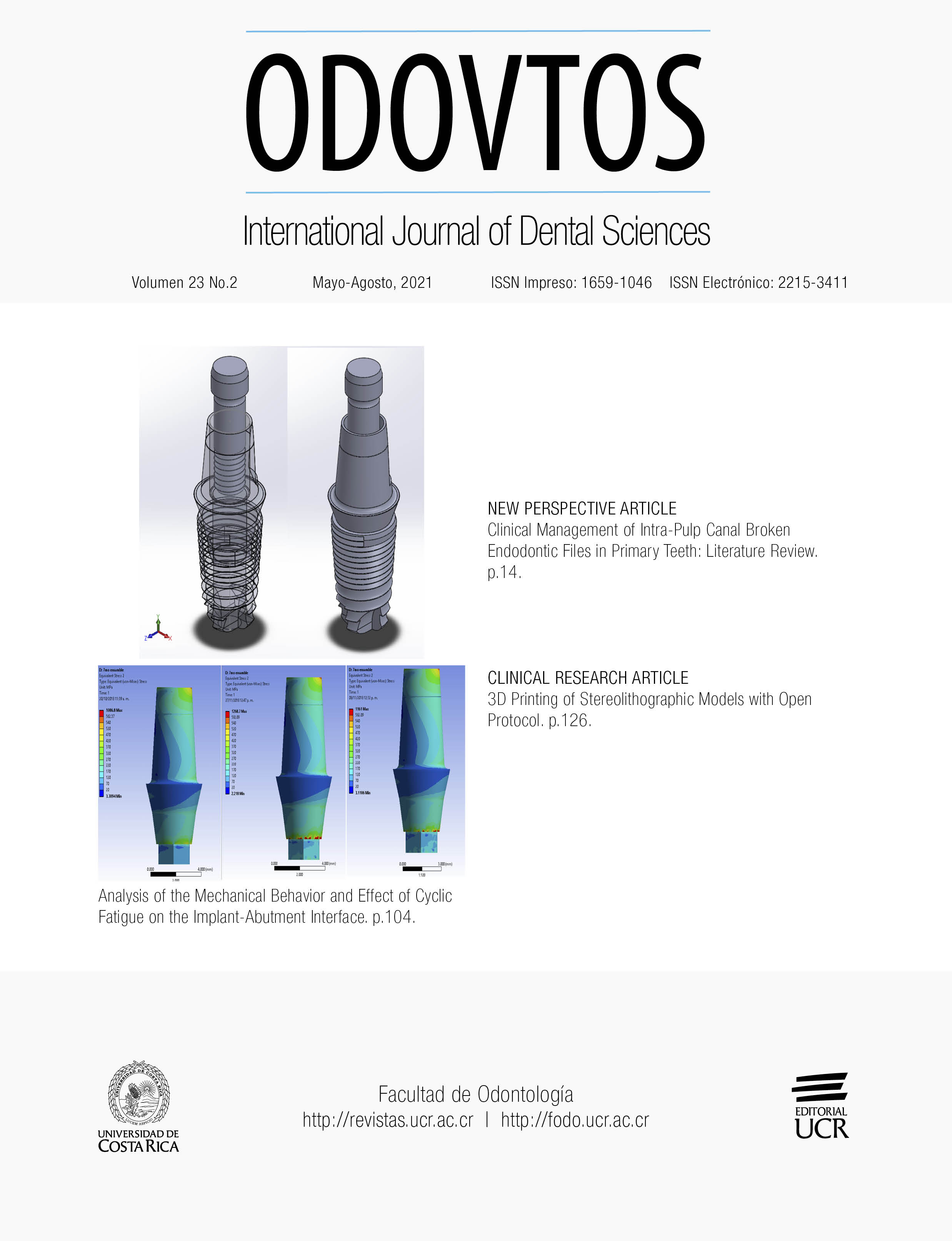Resumen
Objetivo: El objetivo del presente estudio fue evaluar y comparar los efectos de la aplicación superficial de dos resinas humectantes sobre la microdureza superficial y la decoloración de las resinas compuestas. Material y métodos: El presente estudio utilizó dos resinas humectantes y resinas de modelado diferentes. Las resinas compuestas se colocaron en moldes de plástico. Posteriormente, se aplicaron las resinas humectantes sobre la superficie de los dos grupos. Se evaluó la microdureza y el color de todos los grupos. El presente estudio utilizó las pruebas One-Way ANOVA y Kruskal Wallis, para realizar la evaluación estadística (p<0.05). Resultados: Los valores más altos de microdureza se observaron en el grupo Estelite Asteria, mientras que los menores valores se observaron en el grupo GC Essentia (Ultradent). La mayor decoloración se observó en el grupo control o el grupo GC Essentia, mientras que la menor decoloración se observó en el grupo Estelite Asteria con Ultradent Wetting Resin. Conclusiones: Los resultados del presente estudio demostraron que el uso de resinas humectantes, que facilitan la colocación de resinas compuestas, redujo la microdureza y decoloración de las resinas compuestas. El efecto mencionado anteriormente se puede atribuir a las variaciones en la estructura del relleno. Sin embargo, se necesitan más estudios para respaldar y verificar los resultados del presente estudio.
Citas
Sedrez-Porto J.A., Münchow E.A., Brondani L.P., Cenci M.S., Pereira-Cenci T. Effects of modeling liquid/resin and polishing on the color change of resin composite. Braz. Oral Res. 2016; 30 (1): 88-96.
Frauscher K.E., Ilie N. Depth of cure and mechanical properties of nano-hybrid resin-based composites with novel and conventional matrix formulation. Clin Oral Investig. 2012; 16 (5): 1425-1434.
Chang H.S., Hong S.O. Effects of layering technique on the shade of resin overlays and the microhardness of dual cure resin cement. Braz Oral Res. 2014; 28 (1): 1-6
de Paula F.C., Valentin R.D.S., Borges B.C.D., Medeiros M.C.D.S., de Oliveira R.F., da Silva A.O. Effect of instrument lubricants on the surface degree of conversion and crosslinking density of nanocomposites. J Esthet Restor Dent. 2016; 28 (2): 85-91.
Tuncer S., Demirci M., Tiryaki M., Ünlü N., Uysal Ö. The effect of a modeling resin and thermocycling on the surface hardness, roughness, and color of different resin composites. J Esthet Restor Dent. 2013; 25 (6): 404-419.
Barcellos D.C., Pucci C.R., Torres C.R.G., Goto E.H., Inocencio AC. Effects of resinous monomers used in restorative dental modeling on the cohesive strength of composite resin. J Adhes Dent. 2008;10 (5): 351-354.
Muenchow E.A., Sedrez-Porto J.A., Piva E., Pereira-Cenci T., Cenci MS. Use of dental adhesives as modeler liquid of resin composites. Dent Mater. 2016; 32 (4); 570-577.
Toledano M., Cabello I., Yamauti M., Giannini M., Aguilera F.S., Osorio E., Osorio R. Resistance to degradation of resin-dentin bonds produced by one-step self-etch adhesives. Microsc Microanal. 2012; 18 (6): 1480-1493.
Araujo F.S., Barros M.C.R., Santana M.L.C., de Jesus Oliveira L.S., Silva PFD, Lima G.D.S., Faria e Silva AL. Effects of adhesive used as modeling liquid on the stability of the color and opacity of composites. J Esthet Restor Dent. 2018; 30 (5): 427-433.
Chinelatti M.A., Chimello D.T., Ramos R.P., Palma-Dibb R.G. Evaluation of the surface hardness of composite resins before and after polishing at different times. J Appl Oral Sci. 2006; 14:188-92.
Rueggeberg F.A., Craig R.G. Correlation of parameters used to estimate monomer conversion in a light-cured composite. J Dent Res. 1988; 67: 932-7
Yeh S.T., Wang H.T., Liao H.Y., Su S.L., Chang C.C., Kao H.C., Lee B.S. The roughness, microhardness, and surface analysis of nanocomposites after application of topical fluoride gels. Dent Mater. 2011; 27: 187-96.
Erdemir U., Sancakli H.S., Yildiz E. The effect of one-step and multi-step polishing systems on the surface roughness and microhardness of novel resin composites. Eur J Dent. 2012; 6 (2):198-205.
Lombardini M., Chiesa M., Scribante A., Colombo M., Poggio C. Influence of polymerization time and depth of cure of resin composites determined by Vickers hardness. Dent Res J. 2012; 9 (6): 735-40.
Takabayashi Y. Characteristics of denture thermoplastic resins for non-metal clasp dentures. Dent Mater J. 2010; 29: 353-61.
Kang A., Son S.A., Hur B., Kwon Y.H., Ro J.H., Park J.K. The color stability of silorane- and methacrylate-based resin composites. Dent Mater J. 2012; 31: 879-84.
Ergücü Z., Türkün L.S., Aladag A. Color stability of nanocomposites polished with one-step systems. Oper Dent. 2008; 33: 413-20.
Lee Y.K., Yu B., Lee S.H., Cho M.S., Lee C.Y., Lim H.N. Shade compatibility of esthetic restorative materials-A review. Dent Mater. 2010; 26: 1119-26.
Ertaş E., Güler A.U., Yücel A.C., Köprülü H., Güler E. Color stability of resin composites after immersion in different drinks. Dent Mater J. 2006; 25: 371-6.
Bagheri R., Burrow M.F., Tyas M. Influence of food simulating solutions and surface finish on susceptibility to staining of aesthetic restorative materials. J Dent. 2005; 33: 389-98.
Lu H., Roeder L.B., Lei L., Powers J.M. Effect of surface roughness on stain resistance of dental resin composites. J Esthet Restor Dent. 2005;17: 102-8.
Sedrez-Porto J.A., Münchow E.A., Cenci M.S., Pereira-Cenci T. Translucency and color stability of resin composite and dental adhesives as modeling liquids-A one-year evaluation. Brazilian oral research. 2017; 31: 54-62.

